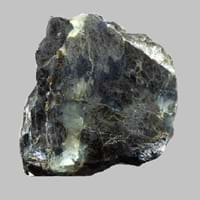Definition
Breccia is a rock consisting of angular fragments of stones which are cemented by finer calcareous material
Pyroxenite is a dark, greenish, granular intrusive igneous rock consisting mainly of pyroxenes and olivine
Discoverer
Unknown
Unknown
Etymology
From Italian, literally gravel, Germanic origin and related to break
From pyro- fire + Greek xenos stranger as the mineral group was new to igneous rocks
Class
Sedimentary Rocks
Igneous Rocks
Sub-Class
Durable Rock, Hard Rock
Durable Rock, Hard Rock
Group
Not Applicable
Plutonic
Other Categories
Coarse Grained Rock, Medium Grained Rock, Opaque Rock
Coarse Grained Rock, Opaque Rock
Texture
Brecciated, Clastic
Clastic, Granular, Phaneritic, Porphyritic
Color
Beige, Black, Blue, Brown, Buff, Green, Grey, Orange, Pink, Purple, Red, Rust, White, Yellow
Black to Grey, Bluish - Grey, Dark Greenish - Grey, Green, Light Greenish Grey
Durability
Durable
Durable
Scratch Resistant
Yes
Yes
Appearance
Layered, Banded, Veined and Shiny
Layered, Banded, Veined and Shiny
Interior Uses
Countertops, Decorative Aggregates, Entryways, Floor Tiles, Flooring, Homes, Hotels, Interior Decoration
Countertops, Decorative Aggregates, Interior Decoration, Kitchens
Exterior Uses
As Building Stone, As Facing Stone, Paving Stone, Garden Decoration, Office Buildings
As Building Stone, As Facing Stone
Other Architectural Uses
Curbing
Curbing
Construction Industry
As Dimension Stone, Construction Aggregate, Landscaping, Roadstone
As Dimension Stone, Building houses or walls, Cement Manufacture, Construction Aggregate, for Road Aggregate
Medical Industry
Not Yet Used
Not Yet Used
Antiquity Uses
Artifacts, Sculpture
Artifacts
Commercial Uses
Creating Artwork, Gemstone, Jewelry
Cemetery Markers, Commemorative Tablets, Laboratory bench tops, Jewelry, Sea Defence, Tombstones
Types
Collapse Breccia, Fault Breccia, Flow Breccia, Pyroclastic Breccia, Igneous Breccia and Impact Breccia
Clinopyroxenites, Orthopyroxenites and Websterites
Features
Available in Lots of Colors and Patterns, Clasts are smooth to touch
Generally rough to touch, Host rock for Diamond, Is one of the oldest rock
Archaeological Significance
Monuments
Not Yet Used
Not Yet Used
Famous Monuments
Not Applicable
Not Applicable
Sculpture
Used
Not Yet Used
Famous Sculptures
Data Not Available
Not Applicable
Pictographs
Not Used
Not Used
Petroglyphs
Not Used
Not Used
Figurines
Used
Not Yet Used
Formation
Breccia is a clastic sedimentary rock which is composed of broken fragments of minerals or rock which are cemented together by a fine-grained matrix and it forms where broken, angular fragments of rock or mineral debris accumulate.
Pyroxenites are ultramafic igneous rocks which are made up of minerals of the pyroxene group, such as augite and diopside, hypersthene, bronzite or enstatite.
Mineral Content
Calcite, Clay, Feldspar, Phosphates, Quartz, Silica
Amphibole, Augite, Bronzite, Chromite, Diopside, Enstatite, Garnet, Hornblende, Hypersthene, Magnetite, Pyroxene
Compound Content
Aluminium Oxide, Ca, NaCl, CaO, Iron(III) Oxide, Potassium Oxide, Sodium Oxide, Silicon Dioxide, Titanium Dioxide
Aluminium Oxide, CaO, Chromium(III) Oxide, Iron(III) Oxide, Potassium Oxide, MgO, Sodium Oxide, Silicon Dioxide, Sulfur Trioxide
Types of Metamorphism
Burial Metamorphism, Cataclastic Metamorphism
Burial Metamorphism, Impact Metamorphism, Regional Metamorphism
Types of Weathering
Biological Weathering, Chemical Weathering, Mechanical Weathering
Biological Weathering, Chemical Weathering, Mechanical Weathering
Types of Erosion
Chemical Erosion
Chemical Erosion, Coastal Erosion, Water Erosion
Grain Size
Medium to Coarse Grained
Coarse Grained
Streak
White
White, Greenish White or Grey
Porosity
Less Porous
Less Porous
Luster
Dull to Pearly
Dull to Vitreous to Submetallic
Cleavage
Non-Existent
Irregular
Toughness
Not Available
Not Available
Specific Gravity
2.86-2.87
3.2-3.5
Transparency
Opaque
Opaque
Density
0 g/cm3
3.1-3.6 g/cm3
Resistance
Heat Resistant, Impact Resistant, Pressure Resistant, Wear Resistant
Impact Resistant, Pressure Resistant, Wear Resistant
Deposits in Eastern Continents
Asia
China, India, Kazakhstan, Mongolia, Russia, South Korea, Uzbekistan
India, Russia
Africa
Namibia, Nigeria, South Africa
South Africa
Europe
Austria, Denmark, Germany, Great Britain, Netherlands, Norway, Poland, Sweden, Switzerland, United Kingdom
Germany, Greece, Italy, Scotland, Turkey
Others
Greenland
Greenland
Deposits in Western Continents
North America
Barbados, Canada, Mexico, Panama, USA
Canada, USA
South America
Brazil
Brazil, Colombia, Venezuela
Deposits in Oceania Continent
Australia
New South Wales, New Zealand
New Zealand, Queensland
All about Breccia and Pyroxenite Properties
Know all about Breccia and Pyroxenite properties here. All properties of rocks are important as they define the type of rock and its application. Breccia belongs to Sedimentary Rocks while Pyroxenite belongs to Igneous Rocks.Texture of Breccia is Brecciated, Clastic whereas that of Pyroxenite is Clastic, Granular, Phaneritic, Porphyritic. Breccia appears Layered, Banded, Veined and Shiny and Pyroxenite appears Layered, Banded, Veined and Shiny. The luster of Breccia is dull to pearly while that of Pyroxenite is dull to vitreous to submetallic. Breccia is available in beige, black, blue, brown, buff, green, grey, orange, pink, purple, red, rust, white, yellow colors whereas Pyroxenite is available in black to grey, bluish - grey, dark greenish - grey, green, light greenish grey colors. The commercial uses of Breccia are creating artwork, gemstone, jewelry and that of Pyroxenite are cemetery markers, commemorative tablets, laboratory bench tops, jewelry, sea defence, tombstones.









